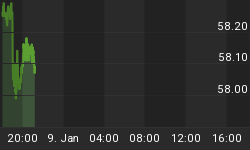The Federal Reserve's current 0% interest rate policy will be more damaging to the US economy than the 1% interest rate policy pursued following the NASDAQ bubble collapse. While home owners were the primary losers from the last Federal Reserve policy blunder, all owners of fixed income assets, especially banks, will suffer from the Federal Reserve's current intervention.
One of the primary goals of having 0% interest rates is to entice banks to employ the carry trade. On the surface, the carry trade supports the Fed's goal of stabilizing the financial system because banks can borrow at near zero while investing in higher yielding government securities. This investment strategy leads to higher bank profits and replenished capital levels. In addition, the carry trade helps fund the federal budget deficit by enticing banks to buy longer-term treasury bonds. While the carry trade may initially seem beneficial, Federal Reserve interference always creates unintended consequences that inevitably outweigh the projected benefits. Below, we attempt to explain the unintended consequences of the carry trade.
Figure 1 demonstrates that the carry trade is in high gear, as indicated by the year-on-year growth in US bank holdings of agency and treasury securities.
Figure 1. U.S. Bank Holdings of Agency and Treasury Securities Y/Y % Growth
Source: ISI
Although some commentators assert that bank holdings of government securities are low on a historical basis (Figure 2), the rapid growth in holdings is a troubling statistic considering the historically high prices and low yields. The accumulation of securities also demonstrates the impact of the Fed's 0% interest rate policy on the bond market.
Figure 2. U.S. Bank Holdings of Agency and Treasury Securities % of U.S. Total Bank Holdings
Source: ISI
Even though the growth rate in holdings of government securities (Figure 1) is comparable to that from other periods of time, the interest rate backdrop today is different than any other time in the last few decades, especially the early 1980s. In the 1980s, interest rates were high while bond prices were low. With limited risk of further increases in interest rates, banks were presented with a win-win situation - if interest rates declined, bank bond holdings would rise in value and borrowing costs on deposits would fall. Additionally, from very high levels, a drop in interest rates would energize the economy and likely lead to higher asset prices. In stark contrast to the early 1980s, today we are dealing with inconceivably low interest rates. Theoretically, interest rates can decline further, but they are so low now that over the medium to longer-term they can only rise.
When interest rates eventually rise, banks will be forced to pay greater amounts on deposits at the same time that their assets fall in price. Therefore, it is no surprise that banks have delevered over the past 20 years (Figure 3). Yet, it is astonishing that leverage still exists at near 10X when, with the odds greatly favoring higher future interest rates, leverage should be nearly non-existent.
There should be minimal leverage in the banking system because treasuries are likely overvalued, thus bank assets too are overvalued and equity overstated. To further demonstrate the risk in the financial system, let us assume that 100% of assets held by banks are treasuries - the safest asset in the world. A decline in treasuries of just 5% would wipe out half of all bank equity capital. Further, if treasuries fell 10%, the majority of banks would be rendered insolvent. However, banks own not only government securities, but also riskier assets and loans that will fall even faster than treasuries.
Figure 3. Banks Total Equity / Total Assets (includes goodwill)
Source: St. Louis Federal Reserve
Despite leverage falling on bank balance sheets, risk remains extremely high as real estate loans are 43% of total bank assets (Figure 4).
Figure 4. Real Estate Loans at All Commercial Banks
Source: St. Louis Federal Reserve
The Federal Reserve created the housing bubble by trying to alleviate the problems resulting from the technology bubble. Now, the Federal Reserve is using the same play book to solve the problems caused by the housing bubble. Once again, the medicine will prove to have been worse than the disease. By encouraging mass buying of treasuries at unsustainably low rates, the Federal Reserve has created another bubble. With low short-term and long-term interest rates, a falling US Dollar, and growing US Government debt, there is significant risk that interest rates will increase in the near future. When interest rates rise, those who have used leverage to buy financial assets will see their cost of borrowing increase as the assets they own decline in value. Such an outcome will be even worse than the deleveraging that occurred in 2008 because today the economy is much weaker and assets are lower yielding (higher priced). It is feasible that even without loan losses the entire banking system would be insolvent if treasury yields rise high enough.
















